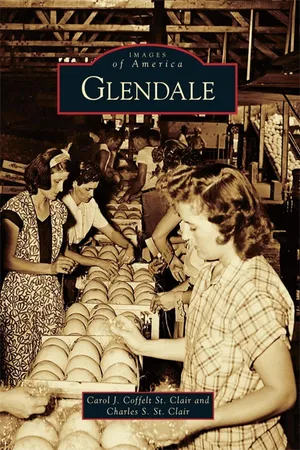![]()
Three
WAR AND PROSPERITY
World War I, for all its tragedies, brought prosperity to the Glendale area. The price of agricultural products soared. Cotton, especially, became a favorite crop; at one time it sold for $2 per pound. Perishable crops—melons, lettuce, and so forth—were also in high demand, and shipping them kept the Glendale Ice Company (later, Crystal Ice Company) busy icing the rail cars that carried the produce east and west. It was not just farmers who prospered. The whole area was seeing boom times and the creation of new businesses such as the Pacific Creamery and the Southwest Flour and Feed Company.
After the war, although slack times for some farmers, Glendale continued to move forward. By 1920, the population had swelled to 2,700, almost three times what it was 10 years earlier. More people meant more housing, which meant that suppliers of building materials and workmen to assemble them were kept busy. In downtown Glendale, many of the ever-popular bungalow-style homes were built in the Catlin Court residential area. Many downtown streets were paved, including Grand Avenue. Streets were renamed and numbered to post office specifications for free mail delivery in town. The high school was regularly graduating some two dozen students, new churches were gaining a foothold, and lodges and civic organizations were flourishing. The new U. S. Government Poultry Experimental Farm was set up south of town, and the whole town celebrated “Chicken Day” in honor of Glendale’s poultry businesses.
Baseball was the popular entertainment, especially when winning teams were fielded. Glendale’s second newspaper, the Saturday Shopper, was first published. And in 1928, to the delight of the whole town, Glendale’s first swimming pool, the Silver Pool, opened to the public. The focus of business was, as it always had been, the streets close to the town park (now Murphy Park). Among other businesses around the park were a hardware store, two dry-goods stores, five markets, a movie theater, and a real estate company.
In the 1930s, a new library was built in the park, and nearby a second grammar school was started. By mid-decade, after the repeal of Prohibition, alcohol-free Glendale permitted the sale of alcoholic beverages. The annual Mexican Independence Day fiesta continued to be a popular fall event, and dial telephones arrived in 1937. By 1940, Glendale’s population had grown to 4,869.
Construction of the Pacific Creamery Company’s milk-condensing plant, half a mile southeast of town, nears completion in 1916 (above). The plant was built in response to soaring milk production during World War I, and it cost more than $400,000 to complete. Its main product was “Armour” brand canned milk. Falling prices for milk after the war brought a decline in the dairy industry, and as a result, the company closed its milk-processing operations in 1920. The plant was reopened as Webster’s Associated Dairy Products Company in 1933 under the ownership of Dudley B. Webster. It operated under two other owners until 1971, when it was closed for good. A look inside the Pacific Creamery Company plant in 1917 (below) reveals a complex array of equipment.
By winning five of six stipulated games in 1916, the high-school boys’ baseball team, the Sugar Kings, were lionized as champions. The girls’ softball team, the Sugar Queens, also had a winning season. They won two of the three games (all against the Indian School team) they played, so they proclaimed themselves champions. The 1916 team consisted of Julia Campbell, pitcher; Vida Roberts, catcher; Frances Green, first base; Gail Campbell, second base; W. Long, shortstop; Ruth Forney, third base; Hazel Spillman, outfield; W. Champie, outfield; and Marguerette Brooks, outfield.
During World War I, Glendale residents bought Liberty Loan Bonds, raised extra crops, and supported the war effort in other ways. Children, as well as adults, found ways to show their patriotism during the war. Youngsters dressed in doughboy attire would routinely defeat the “Hun” on their homemade battlefields. An especially desirable accoutrement, if a boy had one, was a broad-brimmed, military-appearing hat. Toy airplanes were also popular for playing at war. Even though there was no threat of attack in Arizona, these neighborhood boys were prepared with sticks and pretend rifles to defend the home front in 191...




